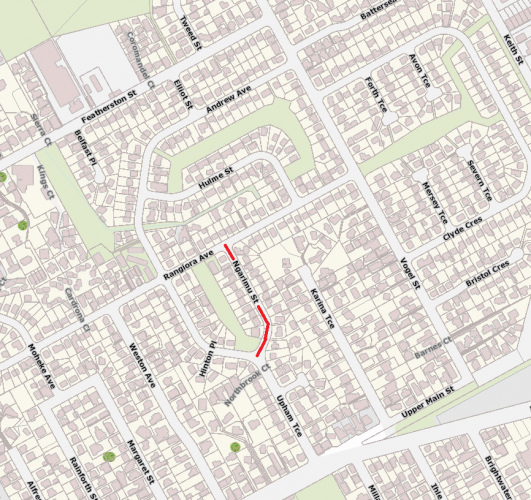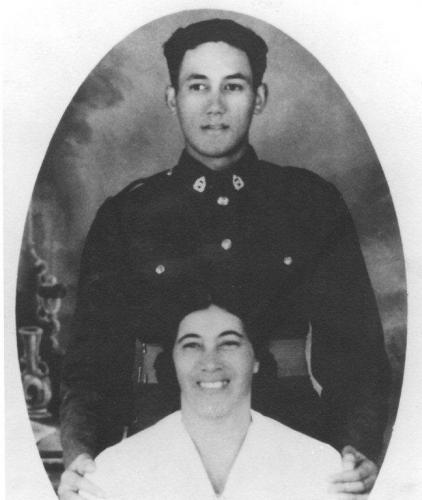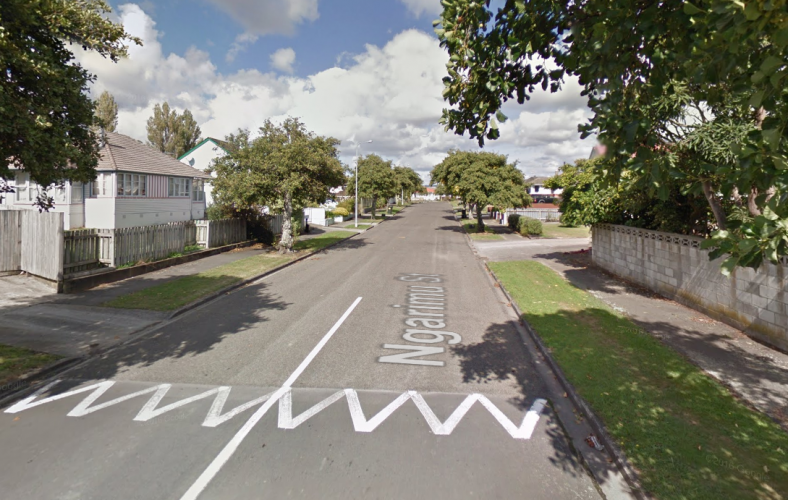117 Ngarimu St Palmerston North, street scene 2017
Reason for the name
This Palmerston North street was named in honour of 2Lt Moana-Nui-a-Kiwa Ngārimu VC
The suburb now known as Roslyn was originally part of the suburb of Terrace End. One of the early residents of Terrace End was Mr Charles Ross, a draper, who built a large house in the area. After his death in 1924, his widow sold 20 acres of land to the Government, who promptly named the area Roslyn in honour him. Following the initial state house development of Rangiora Avenue on this land, further sections to the east of the area were sought for redevelopment. This included sections 173 to 179, owned by J D Buchanan, another prominent Palmerston North local, and this land was purchased by the Department of Housing in in November 1944.
A motion at a Council Meeting on 19 August 1946 created a sub-committee for street naming made up of the Mayor, as well as Councillors Hart and Tremaine. On 17 March 1947 this committee recommended that those roads making up the old Buchanan and Main Street blocks were to be named after suggested Victoria Cross recipients. Although the Palmerston North Branch of the Returned Services Association suggested “VC” be added to each street, this was not adopted.
Ngarimu Street is 300 metres in length and runs from Rangiora Avenue in the north to a merging with Upham Terrace in the south. At its southern end lies the entrance to Rangiora Reserve, with the street having 24 residential houses located on it. Other amenities in the area include Memorial Park, Vogel Street & Main Street parks, and Roslyn Kindergarten.
Author: Evan Greensides, Heritage Assistant for Palmerston North City Libraries & Community Services.
About 2nd Lieutenant Moana-Nui-a-Kiwa Ngārimu
Moana-Nui-a-Kiwa Ngārimu was born at the family home, Maraeake, Whareponga, close to Ruatoria, on 7 April 1918 to Hameura and Maraea Ngārimu . Moana was brought up with close ties to his hapu of Te Aitanga-a-Mate. Raikairoa, Te Aowera and Ngati Horowai, and was the eldest child of a family composed of nine sisters and two boys. Moana grew up in Ruatoria where he attended Whareponga and Hiruharama schools before going on to attend Te Aute College in Hawkes Bay. After completing his fourth form year, he worked as a shepherd on his father's sheep farm until volunteering for the army at Ruatoria on 11 February 1940.
Moana volunteered for the 28th Māori Battalion and entered Palmerston North camp 3 weeks after volunteering, with his fiancée, Hiria (Dah) Walker, also moving to the town. Completing basic training in April, Moana left Palmerston North for the last time on 1 May to join 2NZEF’s Second Echelon in Wellington to be shipped overseas to Great Britain, and later Egypt, aboard the Aquitania.
On 25 March 1941 Moana was sent to Greece with the Battalion as part Lustre Force, the reinforcement of Allied forces in Greece - over 700 men of the Battalion left Alexandria for Athens. While the Battalion fought well in its first action against German forces at Olympus Pass they were soon forced to withdraw back down the length of Greece and then to Crete. It was on Crete that Ngārimu first exemplified himself by taking command of his platoon as a private. After again being forced to retreat from the island, the 28th Māori Battalion returned safely to Egypt, with the next 3 months being a period of adjustment, consolidation and further training. In June and July 1941 the Fifth and Sixth Reinforcements arrived to fill gaps in the line, and the Battalion took part in assault landing training at Kabrit on the Suez Canal.
It wasn’t until the next year that Moana came to the attention of Sir Charles Bennett, future commanding officer of the Māori Battalion, describing Moana as:
[Having] qualities which indicated to me that here you have a chap who is solid, who can be relied upon and a man of good intelligence who was disciplined, a bit of an introvert… He was in control of his situation all the time… If you give him a job to do, you can be sure he will do it.
Moana was appointed as an intelligence officer after being commissioned in April 1942. This, however, was not to last long, as Ngārimu would again find himself in the front lines in order to replace casualties within the Battalion as the advance into Tunisia began.
By late-1942 the Allied forces were on the offensive against Rommel’s Afrika Korps. In February 1943, following the battle of El Alamein and the advance to Tripoli, eight C Company officers, including Ngārimu, wrote to Sir Apirana Ngata describing the battalion’s casualties –they had lost 2 commander’s and had incurred so many casualties that the fittest of the wounded were being used to reinforce the front lines. The officers suggested to Ngata that it was time their men were taken out to rest. Before this would happen, 2nd New Zealand Division would form a major part in the assault on the Mareth Line in Tunisia. In order to break through the line, a left-hook was planned to fall on the German lines at Tebaga Gap, forming six miles of mountainous terrain.
On 19 March the New Zealand Corps and made quick progress, arriving at the Tebaga Gap two days later. While the Corps passed relatively easilty through the Gap, resistance was still strong in the hills surrounding it. It was here that Point 209 dominated the surrounding area and its under-feature, Hikurangi, named after the sacred mountain of Ngati Porou, that the 28th Māori Battalion would face one of its toughest battles. The attack began at 1700 on 26 March, with Ngārimu leading 14 Platoon on the left flank of the hill, with 15 Platoon taking the centre and 13 Platoon completing the assault via the right flank. While poor map reading resulted in artillery fire being poured on the wrong hill, Ngārimu and his men advanced over open ground against the German positions.
With 15 platoon pinned down at the base of Hikurangi, 14 Platoon charged up the hill, with Ngārimu destroying 2 machine-gun positions by himself before summiting the hill first. An intense fire-fight erupted, after which 14 Platoon dug-in on the west slope, the Germans retreating to the east side with support fire from Point 209, and stalemate ensued. As night fell the German forces took the initiative and counterattacked over the crest of Hikurangi, with the rocky terrain making it difficult for the men to dig in. While many were wounded during the continuous attacks, Ngārimu stood up in front of his men and yelled at them to move forward and engage the enemy, himself firing his tommy-gun from the hip as they went forward. Although hit by a bullet in the shoulder, Ngārimu continued to personally lead his men. At one point, having run out of grenades, he began to throw large stones at the retreating Germans. As the night continued, the fighting devolved into prolonged skirmishes and hand-to-hand fighting which eventually forced 14 Platoon off the crest. Ngārimu, in a “majestic fighting mood”, rallied his men and retook the crest of Hikurangi, in the process receiving another wound, this being shell splinters to the leg.
Near dawn, the commanding officer of the 28th Māori Battalion, Lieutenant Colonel Charles Bennett, ascended Hikurangi to assess the situation. Seeing both captain Awatere and 2nd Lieutenant Ngārimu wounded, he ordered them evacuated to the nearest aid post, whereupon Ngārimu stated, “I’m alright, Sir. Let me stay a little longer with my men”. Stating that the hill was to be held at all costs, Colonel Bennett accepted the request to stay, with Awatere replying, “Have no fear, Sir. This hill will never be lost”. As Lieutenant Jackson was requesting further reinforcements for the beleaguered men on Hikurangi and stating that Ngārimu’s actions were worthy of a Victoria Cross, a reinforced German assault came over the crest of the hill in full view of the Battalion headquarters. Again charging ahead, firing his submachine gun from the hip and urging his men forward, Ngārimu reached the crest and was shot through the chest. The battle then raged around his body, the Germans finally being pushed back to Point 209, never to regain Hikurangi. Testament to the severity of the fighting on Hikurangi and Point 209, every British gallantry medal was afterwards awarded at least once to the men of 28th Māori Battalion, with over 90 casualties suffered by C Company of the Battalion in 36 hours of fighting.
On 2 June 1943 General Freyberg sent a telegram to Prime Minister Peter Fraser notifying him that the King had approved the posthumous award of the Victoria Cross to 2nd Lieutenant Ngārimu. On 6 October, members of Ngati Porou and Wanau-a-Apanui gathered at Ruatoria to witness the investure of the Victoria Cross by Governor-General Sir Cyril Newall to the Ngārimu family. After the ceremony, attended by around 7000 guests, Hamuera Ngārimu spoke solemnly about his son’s feats:
Mrs Ngārimu and I wished that Moana could be here to the tribute, take pride… to all the Māori people because of what he did to win the Victoria Cross. He loved his country so well that he was glad to die for it.
2nd Lieutenant Moana-Nui-a-Kiwa Ngārimu is buried in the British Military Cemetery at Sfax, Tunisia. A fund to support Māori education, the Ngārimu and 28th Māori Battalion Scholarship, was set up in 1943 to commemorate his actions and the values of the men he fought with. His Victoria Cross is currently on loan to the Tairawhiti Museum, Gisborne.
Honours and Awards
- Victoria Cross
- 1939-45 Star
- Africa Star w/8th Army Clasp
- Defence Medal
- War Medal 1939-45
- New Zealand Medal
Citation for the Victoria Cross:
During the action at the Tebaga Gap on 26 March 1943, 2nd Lieutenant Ngārimu commanded a platoon in an attack upon the vital hill feature, Point 209. He was given the task of attacking and capturing an under-feature forward of Point 209 itself and held in considerable strength by the enemy. He led his men with great determination straight up the face of the hill, undeterred by the intense mortar and machine-gun fire, which caused considerable casualties. Displaying courage and leadership of the highest order, he was himself first on the hill crest, personally annihilating at least two enemy machine-gun posts. In the face of such a determined attack the remainder of the enemy fled, but further advance was impossible as the reverse slope was swept by machine-gun fire from Point 209 itself.
Under cover of a most intense mortar barrage the enemy counter-attacked, and 2nd Lieutenant Ngārimu ordered his men to stand to and engage the enemy man or man. This they did with such good effect that the attackers were virtually mown down, 2nd Lieutenant Ngārimu personally killing several. He was twice wounded, once by rifle fire in the shoulder and later by shrapnel in the leg, and though urged by both his company and battalion commanders to go out, he refused to do so, saying that he would stay a little while with his men. He stayed until he met his death the following morning.
Darkness found this officer and his depleted platoon lying on the rock face of the forward slope of the hill feature, with the enemy in a similar position on the reverse slope about twenty yards distant. Throughout the night the enemy repeatedly launched fierce attacks in an attempt to dislodge 2nd Lieutenant Ngārimu and his men, but each counter-attack was beaten off by 2nd Lieutenant Ngārimu's inspired leadership. During one of these counter-attacks the enemy, using hand grenades, succeeded in piercing a certain part of the line. Without hesitation this officer rushed to the threatened area, and those of the enemy he did not kill he drove back with stones and with his tommy-gun.
During another determined counter-attack by the enemy, part of his line broke. Yelling orders and encouragement, he rallied his men and led them in a fierce onslaught back into their old positions. All through the night, between attacks, he and his men were heavily harassed by machine-gun and mortar fire, but 2nd Lieutenant Ngārimu watched his line very carefully, cheering his men on and inspiring them by his personal conduct. Morning found him still in possession of the hill feature but only he and two unwounded other ranks remained. Reinforcements were sent up to him. In the morning the enemy again counter-attacked and it was during this attack that 2nd Lieutenant Ngārimu was killed. He was killed on his feet defiantly facing the enemy with his tommy-gun at his hip. As he fell he came to rest almost on top of those of the enemy who had fallen, the number of whom survived testified to his outstanding courage and fortitude.







